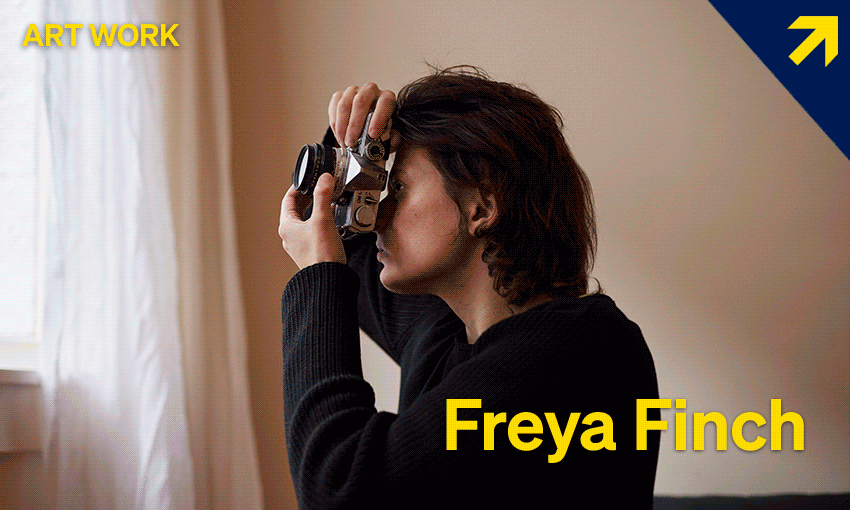Freya Silas Finch is a multidisciplinary queer and trans artist working across theatre, film and performance art. They have taken part in the film intensive A Wave in the Ocean, run by Dame Jane Campion, and are in rehearsals for their solo show A Slow Burlesque with Silo Theatre.
What their arts practice is
I’ve been working all through my 20s in theatre – as an actor and also devising. In the last couple of years I’ve moved into filmmaking as well. At first I tried to do that independently, which was pretty challenging, but then I was very lucky to be a part of A Wave in the Ocean last year, which is the Jane Campion film intensive. It was a huge deep dive into filmmaking and I learnt a lot.
I have other things that I do creatively – I love taking photos, I write, I draw – but those things are more just for me as a person and a creative being, and less the part of my practice that is my career.
How their practice manifests in their day-to-day life
At the moment I’m getting ready to do my Silo Theatre show, A Slow Burlesque, in October. So there’s meetings happening to get everything organised and some final development on the script. At the same time I’m doing pre-production work on my short film which I’ll shoot after my show. So I’m getting a lot of the production stuff sorted ahead of time. That’s similarly a lot of meetings, writing, and a lot of dreaming. There’s a lot of thought that goes into making art!
My days vary. I just had a week down south that was purely dedicated to writing my film. Those days were literally just writing all day. But then I come back to Tāmaki and it’s meetings, emails, Zooms, calls, location recces. I find the life of an artist can be very bitsy. Lots of different things may come up during the week.
How their show developed
Well, it’s an idea I had some years ago. I’d have long periods where I wasn’t thinking about it and then it would come back to me, and I’d think, “There’s something there.”
I started to develop it more a couple of years ago through workshops with friends. My friend Ella-Hope Higginson organised this great initiative called Solo Camp where a bunch of us would get together, hire a space and work on our solo shows together. After that, I went to New York for a month and did a residency at MothershipNYC; it was a concentrated period of dreaming up the show, working with Sophie [Roberts, artistic director of Silo Theatre] via Zoom and testing some of the pieces to a lovely New York audience.
I’ve done three blocks of development with Silo since then. We tend to work four or five days at a time, me and the other collaborators in the room, bringing the work to life.
The artists they look up to
I feel inspired by the artists working on this show with me; Jo Randerson, Kirsty Cameron, Sophie Roberts, Josie Archer and many more wonderful collaborators.
In other art forms, right now I love the work of Solomon Mortimer, Joshua Taylor (Ford’s Factory), Christian Dimick and Womb. It inspires me to see artists later in their career who have been doing it for so long, who are still making work. I don’t think I could ever ever quit art making because it’s my life source, but you do have moments where it can be quite exhausting, so to see people who’ve made a lasting commitment to their practice and their work is inspiring.
The support systems that keep them going
On a more personal and spiritual level what supports me is that I’m meditating a lot! I’ve always dreamt of being a meditator, and now I’m actually doing it, so that’s nice. That’s just like a daily thing I can do – even if I do five minutes, it’s better than nothing. My partner, my friends and my family are also a huge support system, they make life so wonderful and I often collaborate with them too!
Nature is a huge support system for me. Last year when I was living in Pōneke, there was a bush walk right by my house, and I would do that often. I feel really energised in nature. I’ve had a very lucky couple of years doing A Wave in the Ocean, I got an Arts Foundation Springboard award, and I’ve been supported by Silo with the commission of this show.
I’m very used to having a 40-to-50 hour a week hospo job while also making art. But since the start of last year I haven’t had to have another part-time job. I just have so much more time to give. It means that the work gets deepened because I can afford to sit with it for longer. I’m coming to it with more energy. That said, I don’t regret any of the jobs I’ve done over the years, I’ve had many interesting jobs and met all sorts of great people that way.
What structural changes would make their life easier
I think a universal basic income… like, why are we not all doing that!? That shouldn’t only be an artist’s dream! That should be the society we all want to be living in.
For artists, the money is often coming all at once, and you think, “Oh my gosh, this amazing lump sum!” But you don’t know when the next lump sum is next coming – do I need to make this last three months, six months, however long?
I think the changes Creative New Zealand have made are really cool, because often funding is based on executing something whereas now it seems more money is going into supporting artists to just live and develop work. But the reality, with our government right now, is that 1,000 people applied for the last funding round and something like 50 got it. The new CNZ model is amazing, but the amount of money going toward the arts, which is a government issue, is not enough. What are those other 950 artists living off?
Something amazing they’ve seen
The first thing that comes to mind is ScatterGun, which is such an amazing piece, such a moving piece. It could only be made by Ana [Chaya Scotney], and only be made in Aotearoa. I feel lucky to have witnessed that piece of work. It felt electric in the theatre.
I’m also thinking of the work of [choreographers] Josie Archer and Kosta Bogoievski, who are dear friends and collaborators of mine. When I saw some of the work that they did in Auckland six or seven years ago now, I just loved it so much. I felt like I hadn’t seen anything like that. Their approach to dance and performance is really, really interesting. They’re just people who live and breathe it. Their practice is their life, which I find so inspiring.
What still excites and inspires them
There’s a spirit of curiosity that you have as an artist that makes me feel like I made a job out of the things I loved to do as a kid. I’ve somehow made pulling things out of the dressing up box and putting on plays in my living room into a job.
I love the collective nature of all art, but particularly theatre. There’s nothing that I love more than sitting in that dark room going on a journey with people together. It’s a human ritual that is deserved by us all. It brings me back to the importance of art.
I have a very active mind; sometimes I can feel my thoughts racing at a million miles an hour. But when I’m on set filming something or I’m in rehearsal or I’m on stage – when I’m immersed in that, my mind switches off to everything else. I love that feeling.
A Slow Burlesque is on at the Basement Theatre, Auckland, October 3-19.

